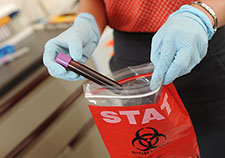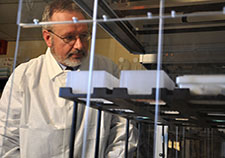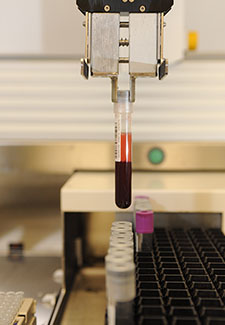Office of Research & Development |
 |

VA Research Currents archive
June 21, 2016

In most PTSD gene studies, participants provide blood samples from which DNA is extracted. (Photo by Frank Curran)
Nearly two decades ago, researchers with VA and other institutions reported on a gene that appeared to be linked to schizophrenia. Today, a number of drugs that target the alpha 7 nicotinic receptor are in clinical trials.
A similar process is underway for posttraumatic stress disorder. Studies have pointed to several genes that appear to affect PTSD risk. Researchers caution there's still a long road to haul—as has been the case in schizophrenia—but they are confident they're moving in the right direction.
"There's a good chance" there'll be a payoff, notes Dr. Nathan Kimbrel, who studies PTSD genetics at the Durham VA Medical Center and Duke University, with support from VA Research's Career Development program. "It just takes a long time."
"When we get enough statistical power, we should see more consistent results. We're just not there yet."
His group has conducted a number of studies in the past few years in which Veterans give blood samples and take part in clinical interviews and surveys.
The group reported last fall, for example, on a possible link between PTSD and a gene called CHRNA5. A nicotine receptor gene, CHRNA5 has also been tied to an increased tendency to smoke cigarettes and become dependent on nicotine.
Prior to that, in a study of more than 1,600 Iraq and Afghanistan Veterans, Kimbrel and colleagues homed in on a genetic variant called APOE4—known mainly for its links to Alzheimer's disease. APOE4 is present in about 1 in 5 people. Interestingly, in the study, it appeared to heighten PTSD risk only in those Veterans who had been in heavy combat. Among those with low exposure to combat, it didn't seem to matter whether they carried the APOE4 allele or not.

Dr. Don Humphries, with the VA Boston Healthcare System, helps manage VA's Million Veteran Program. MVP data will figure in a genome-wide association study of PTSD that is now in its early stages. (Photo courtesy of MVP)
Another gene, SLC6A4, which affects levels of the neurotransmitter serotonin in the brain—essential for mood—figured in another 2015 report by Kimbrel's team. Having a certain variant of the gene, known as 5-HTTLPR, increased the odds of a PTSD diagnosis by around 50 percent—but only in African American Veterans. No such effect was seen among whites in the sample of 1,105 Veterans. Unlike APOE4, though, this gene did not differ in its effects based on intensity of combat exposure.
At least a dozen or so other genes have popped up in the PTSD genetics literature in the past couple of years. Some findings have been replicated across studies by different groups; others haven't. Trying to address how genetic risk might be affected by individual factors such as race, ethnicity, gender, and combat experience further complicates the equation.
On the one hand, there's wide agreement that PTSD—like other mental illnesses—does have a genetic component. But some experts question whether that genetic influence might be too diffuse, too multifaceted, to allow for the identification of specific drug targets.
Dr. Mark Miller, with VA's National Center for PTSD in Boston, says, "There are quite a few twin studies that have documented there's a heritable influence on PTSD, as there is with all mental illnesses." Much of that research has been based on VA's Vietnam-Era Twin Registry.
"That's what molecular geneticists are chasing after—they are trying to explain that heritability," says Miller.
At the same time, he concedes that "there probably are skeptics of molecular geneticists' ability to identify the genetic component."
Dr. Murray Stein, with VA and the University of California, San Diego, is well-known in the field of PTSD and anxiety disorders. He too acknowledges that so far, the evidence for any single PTSD gene—or set of genes—is limited.
"I run into people who are not impressed with the size of the effect, with the amount of variance that we can explain with molecular genetics at this point," says Stein. "I think everyone who works in this area is aware of that."
However, he points out that "this is a criticism you could probably level at a lot of molecular genetics research."
Kimbrel adds that the field of psychiatric genetics, in particular, is relatively young. "I think there's good reason to think that as it develops, we'll see more compelling results."
PTSD gene hunters use two main approaches. In one, they focus the search on specific "candidate genes" known to affect the body's response to stress.
A good example is the gene for CRH, a hormone involved in the HPA axis. This system involves the hypothalamus, the pituitary gland, and the adrenal glands, and the complex chemical interactions among them. The adrenals, for example, produce hormones called glucocorticoids—including cortisol—in response to messages from the pituitary. Those hormones, in turn, act back on the pituitary and the hypothalamus in a negative feedback loop.
Miller: "It seems unequivocal that the HPA axis is involved. And we know an awful lot about that, and how it's regulated, and how it may be dysregulated in PTSD."
As a result, points out Stein, "it makes sense that people have gone in and looked at genes in this system."
The other method is the genome-wide association study, in which researchers approach the question with no preconceived ideas, no target genes in mind. They simply scan the genomes of large groups of people—some with PTSD, others without—and check millions of possible variants, with the help of super-fast computers, to see which turn up in one group but not the other.
Stein was lead author on one such study that appeared online in JAMA Psychiatry in May 2016, based on the larger Army Study to Assess Risk and Resilience in Servicemembers (STARRS) study. The gene study included some 13,690 service members in all—some with PTSD, and some who had been exposed to similar traumas but did not develop PTSD.
As in the Durham-based study noted above, the results differed by race. Among African Americans, a gene called ANKRD55 was statistically associated with a higher PTSD risk. The gene is known to play in a role in several autoimmune and inflammatory disorders, including arthritis and multiple sclerosis. Interestingly, other research has looked at the role of inflammation in PTSD.
Among European-Americans in the study, the ZNF626 gene emerged. Its role in other health conditions is not well-established.
In neither case, though, was the effect of the gene variant particularly strong.
Stein points out that genome-wide association studies thrive on huge data sets. While the Army STARRs publication represents the largest such study on PTSD to date, results from an even larger effort, by the international Psychiatric Genomics Consortium, are now pending publication. The consortium, which involves Stein, Miller, and several other VA scientists, previously reported on a target enrollment of 40,000 people, including 10,000 with PTSD. But, says Stein, even those kinds of numbers may not be enough to guarantee replicable results.

Marine Corps recruits go through training in San Diego in 2016. Experts say genetic tests for PTSD risk might eventually be used to help tailor military assignments, or to target some troops for extra resiliency training. (Photo by Lance Cpl. Angelica I. Annastas/USMC)
"There are a handful of genome-wide association studies that have been replicated, and some that have not," says Stein. "I think the bottom line is that until we get to very, very large samples, like those we've seen in schizophrenia, where some of the recent studies have had up to 200,000 or so people in them, we are going to see some findings replicated and others not. When we get enough statistical power, we should see more consistent results. We're just not there yet."
For his part, Stein is also co-leading, with Dr. Joel Gelernter, a genome-wide association study of PTSD in collaboration with VA's Million Veteran Program. About 18 percent of the Veterans enrolled in the genomic research program have reported a diagnosis of PTSD. Ultimately, that may represent up to 180,000 or so Veterans with PTSD.
"MVP is a marvelous resource for the field," says Stein. "It's going to be a lot of help."
Miller says that the two approaches—genome-wide association studies, and studies focused on candidate genes—"work best when they're used to inform each other."
Stein notes that with schizophrenia, it was genome-wide association studies that led scientists to discover genes they hadn't thought of previously, and that are now driving drug development.
"Initially people were focused on dopamine genes and some others, because it was thought that's where the biology was. But then these large genome-wide association studies pointed them in directions nobody would have thought of if those studies hadn't been conducted. So science moves ahead by using both approaches. I think it'll do that in PTSD eventually, too."

VA's Million Veteran Program biorepository uses robotic equipment to process up to 2,500 or so incoming blood samples per week. Large numbers of research participants are crucial in studies aimed at identifying PTSD genes. (Photo by Frank Curran)
Dr. Erika Wolf, who collaborates with Miller at the National Center for PTSD, points out that each approach has its own burden of proof. That might help explain why the findings from candidate-gene studies often appear to be more substantial and more promising than those from research focused on the whole genome.
"If you're using a hypothesis-driven approach, and you know a specific biological system, like the HPA axis, that's been shown to be related to PTSD, the empirical burden for showing an association is generally not as stringent as it would be if you were examining every SNP [pronounced "snip"—a type of genetic variant] that you have access to in the genome."
Wolf, like Kimbrel, has been supported by VA's Career Development program. One theme in her research has been identifying subtypes of PTSD, and, correspondingly, subtypes of genetic risk factors. This line of inquiry, she says, ties in to the wider "precision medicine" movement the White House has been promoting.
"It's unlikely that there's only one genetic variant, or even a handful, that are relevant for all cases of PTSD," says Wolf. "There are probably subgroups of individuals who have different genetic risk factors that contribute to the disorder. So in the long run, there could be payoffs in that regard—identifying specific subgroups of people based on their genetic types, and tailoring treatment based on that."
Another complicating factor in the search for PTSD genes is that diagnosing the disorder is not as cut and dried as diagnosing conditions such as diabetes or arthritis. If, say, 20 percent of the Veterans with a PTSD diagnosis in their medical record don't truly have the condition, that would seriously throw off the results of studies comparing these Veterans with non-PTSD controls and looking for gene variants found in one group but not the other.
Diagnostic fuzziness could also help explain the varying results seen across PTSD gene studies. Some studies, especially larger ones, rely on participants' self-reports of their condition. Others use diagnoses pulled from medical records. Still others use what is seen as the diagnostic gold standard—a clinical interview by a psychiatrist or psychologist. But even those diagnoses still rely, to an extent, on the professional's subjective opinion.
"The PTSD diagnosis ultimately comes down to the judgment of a clinician," says Miller. "One of the big challenges is that relative to cancer or some other diagnosis where there's a clear biomarker of the disease, we don't have anything like that in PTSD. For that matter, we don't have it in any psychiatric condition."
What would help, say the experts, is an objective biomarker, based on a blood test or brain scan. If hard-and-fast biological indicators of PTSD could be established, this would enable PTSD gene hunters to proceed in a more sure-footed manner.
Miller: "There are a lot of interesting biomarkers being studied, but I wouldn't say we're on the verge of a breakthrough. But there is a movement toward trying to get away from the DSM-based diagnostic system to other approaches. I think that's going to be part of the way forward in our getting a stronger understanding of the genetics and neurobiology of PTSD."
The DSM, or Diagnostic and Statistical Manual of Mental Disorders, offers diagnostic criteria for PTSD. The criteria may change slightly with each edition, which further complicates things.
In the MVP-based genome-wide association study led by Stein and Gelernter, the team is not planning to rely solely on Veterans' self-reports of their PTSD diagnosis. Besides providing a blood sample from which DNA is obtained, MVP participants fill out extensive surveys about their health, lifestyle, and military experience, including topics such as PTSD and trauma exposure.
"The work that's gone on so far," Stein explains, "is to develop and validate an algorithm that enables us to go into the VA electronic health record and pull out people who probably do have PTSD [based on their formal diagnosis, versus what they self-reported], and then take a look at the actual survey data they provided to MVP. We then should be able to determine, out of the total numbers of those who might have PTSD, how many are we fairly confident that they actually do. And we can also identify the people who have been exposed to trauma but don't have PTSD."
Even if this MVP study, or the worldwide consortium efforts, do allow researchers to home in on specific genes, it still may be years before a safe, effective drug based on those biochemical pathways can be brought to market. In any case, improving treatment remains the primary goal of PTSD genetics.
Another outcome of the research, though, perhaps in the shorter term, might be some sort of screening tool for the Department of Defense. But this probably wouldn't play out in the way some might fear—as a way to exclude recruits with an unfavorable genetic profile.
Stein says that when his group presented genetics data from Army STARRS at the Pentagon, "the first thing the military psychiatrists said is that we'd never use this to exclude someone from being in the military, unless you told us they had a 100 percent chance of getting PTSD. And even then, we would probably still want them in the military, but perhaps not in combat.
"What we've been told by the military," adds Stein, "is that they're unlikely to be in a position where they're going to want to turn away people who otherwise would be considered good soldiers. But, if we did have something that said, hey, there's a real high likelihood this person is going to have mental health problems if they're in combat, then they would try to come up with some way to make those individuals more resilient."
Wolf points out that if the military really wanted strong predictors of PTSD risk, there are factors they could easily look to besides genetics.
"We have a lot of predictors of PTSD that are not genetic and that have much stronger effect," she says. She cites three examples: prior PTSD, substance use, and certain psychological traits known as internalizing behaviors.
Miller suggests another perspective on what PTSD gene research might mean for the Pentagon:
"A military application that might be more palatable to a lot of people is the flip side of the PTSD question, which is resilience. My guess is that the military would be better off spending time trying to identify highly resilient individuals and matching assignments to them, rather than identifying the vulnerable ones and trying to keep them out of it."
One might think these are simply two sides of the same coin, from a molecular genetics perspective—that one variant of a gene might increase PTSD risk, whereas another variant of the same gene might enhance resilience. It's not that simple, asserts Wolf.
"There have been some studies that have tried to show that—for example, COMT as the 'warrior-worrier gene.' But I don't think that's been borne out. One of the issues is that resilience is not just the lack of psychopathology in response to trauma or other exposures."
There are personality characteristics, such as hardiness, she says, that play a role in resilience, but their absence doesn't necessarily predispose a person to PTSD.
Notwithstanding those nuances, Miller contends that "the research on the neurobiology of PTSD crosses into an interesting scientific space where you may learn about what makes some people more resilient to adverse environments. If anything, I would think that would be the most useful information for the military. But of course, most of the funding gets directed toward the health problems—in this case, PTSD."
If that trend should change, and more interest builds toward resilience research, scientists like Miller stand ready to take up the challenge.
"It's typically the same people doing both types of studies," he says. "Presumably there's a spectrum of individual differences [including genetic variants] that confer risk or resilience. And there are a lot of researchers interested in trying to map out that whole spectrum."